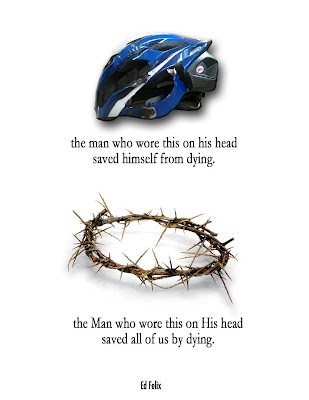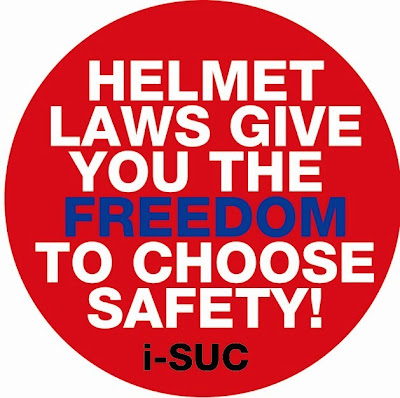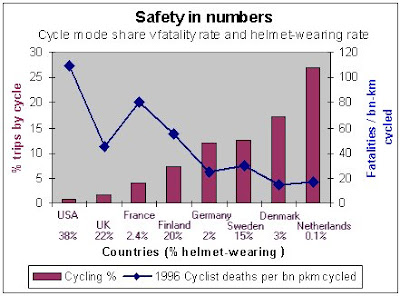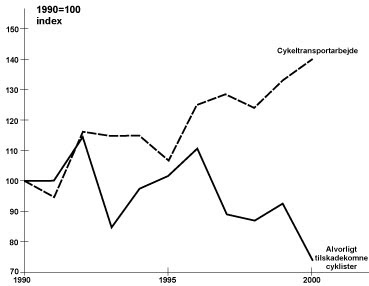
Here in Denmark there are currently two debates going on relating to headwear. One is the muslim headscarf and the other is the bicycle helmet. The similarities between the two debates are striking and not a little unsettling. Not least because Denmark is experiencing an unfortuanate wave of helmet promotion that is putting our wonderful, advanced bike culture at risk. The headscarf, like other religious symbols such as the christian cross or the jewish kippah, is worn because of one's faith and beliefs. The individual wears such symbols in subservience to their god and in the sub-conscious hope and belief that this symbol will somehow protect them from evil, danger or what have you. The bicycle helmet is also worn because of a belief that this polystyrene shell will protect the wearer from percieved inherant dangers involved in cycling, including serious head injury or even death.
Bumper sticker from International Safety Union for Cyclists As an atheist – which is really just a silly word for those of us who prefer humanism over monotheism – I'm not a big fan of religious symbols or subservience. I am, however, a big fan of science, although I am not a scientist. I merely choose to seek answers in scientific research. Science and god will never go for a bike ride together. They are two opposite poles in the human mind. God remains a belief, stronger in some than in others. It is quite the same for bicycle helmets. Science tells us what we need to know about them, and yet people insist on sticking to their beliefs that they are wearing a polystyrene, all-powerful halo that wards off all traffic evils and will ensure a long, healthy life. To be honest, when I walk down the street or ride by bike through town I don't notice what religious symbols my fellow citizens are wearing, whether headscarves, burkhas or a cross on a chain. My life is too short to notice. They're just fellow citizens who are an integral part of my society. The same can be said of the occasional cyclist who rides past wearing a helmet. Just a regular young woman going to work or the supermarket or a nightclub. A young woman who falls in love, laughs and cries, pays her taxes. All the things homo sapiens do. These regular people are harmless and they are important cogs in the societal wheel. They don't preach their respective beliefs to others. They just do what they want to do of their own free will. Things become rapidly different when we look at fundamentalists. Regardless of religious leaning or the name of their god. The loud, vocal and arrogant mobs who want us all to be just like them and who look down at others for not having 'seen the light'. Sad, intolerant, individuals strengthed by the volatile shoutings of clerics. Unfortunately, the bicycling world has its own fundamentalists in the form of bicycle helmet advocates. They are loud and intolerant and they reject science with the same fervour as they embrace their beliefs.
Sticker from International Safety Union for Cyclists. A spoof site, but great all the same.
This was spotted recently on the internet. Not even as a spoof. Which kind of supports this article:

NAGGING AND BULLYING
What started this train of thought was a recent email from a Copenhagenize reader in America who lamented the fact that he experiences nagging and bullying from other members of his bike club because he refrains from wearing the symbol of their beliefs – the bicycle helmet. I've recieved many other emails in this vein.On occasion I ride with the local cycling club (of which I'm a dues paying member) to enjoy a long ride on rural roads and some vigorous exercise not afforded by my daily errands. I have never been able to enjoy a ride without at least two people nagging or trying to bully me into wear a helmet. Sometimes shadowy "club rules" are cited, but I've found no mention of helmets in my membership application and the application contains a liability waiver in case of accident. Even if bicycle helmets were effective at preventing serious injury the behavior I encounter would be considered rude by decent people. And in fact the behavior of the other club members is polite in every other regard.I am aware of The Helmet Wars in other countries. BikeSnobNYC attended an event in NYC in which Jan Gehl, the legendary urban planner, was speaking about Copenhagen:The extra insult is the rudeness is accompanied by the presumption that I am an inexperienced and ignorant cyclist who just doesn't know better. I am new to this area, but I've worked in the bicycle industry for several years and I support my family with a bicycle business that I own.
Trillin was followed by Jan Gehl, the Danish architect, who described how over the past 30 years Copenhagen has been transformed into a pedestrian paradise thanks largely to bicycle-friendly city planning. Gehl was charming, despite an inordinate number of lascivious asides about how much easier it is to gawk at women while riding a bicycle. (Then again, he does live in Copenhagen). The crowd ooh-ed and ahh-ed every time Gehl displayed another slide of a happy person biking in a pristine bike lane, or every time he cited a statistic showing how many people in Copenhagen ride to work. In fact, the only time they stopped sighing longingly was when Gehl off-handedly mentioned that because Copenhagen has no helmet laws people don't need to bother wearing them. Suddenly the audience was silent and you could hear people shifting in their seats uncomfortably. Apparently even the most progressive Americans are not ready to accept the concepts of freedom of choice or personal responsibility.I've often wondered how I would react if someone mumbled ”where's your helmet” to me on the bike lanes of my beloved Copenhagen. I may be tempted to harbour thoughts of smacking them one, but that would be frightfully un-European. It isn't necessary to be aggressive because I know that the average Copenhagener just isn't aware of the facts. It just isn't cricket to smack the uninformed.
A BIKE CULTURE UNDER FIRE
As mentioned at the beginning we are experiencing a spate of helmet promotion and we've never really had any helmet debate before, so it is understandable that the average Dane hasn't been presented with the facts. The only time we had some helmet promotion was back in the early 1990's and the number of cyclists fell sharply and drastically as a result. I had hoped that we had learned from that regrettable mistake but then came a poster campaign from the Danish Cyclists' Union and the Danish Traffic Safety Board. Fortunately, Denmark is, by and large, a rather secular nation. Only 7% of the population in Copenhagen go to church and the national level is 20% - most of the churchgoers live in rural areas and the church is more of a social club for the local area. Danes have a reputation for prefering to engage themselves in social activities and also for being well-informed and well-educated about their society and the world at large. I am putting my money on this fact with regards to the bike helmet debate here. Because there has been a lack of information available to the public, Marie and I started a website called Cykelhjelm.org – in order to allow our fellow citizens to form their own opinions instead of merely being fed a handful of vague, but carefully selected stats from the public organisations seeking to create a doctrine on which the faithful can plant their new faith. I know the vast majority of my fellow citizens will tackle the subject wisely. However, there are fundamentalists showing up on the radar. Facebook groups that preach the catch phrases they have memorized from the promotion campaign.
”It is common sense to wear a helmet!”
”Strap on your helmet and avoid brain injury!”
Safety in Numbers - respectable stats stand to fall I am fearful that this fear-mongering helmet promotion will infest our bike culture. We already have the world's best cycling safety statistics, second only to the Netherlands, thanks to our separated bike infrastructure. A drop in cyclists, however, affects the Safety in Numbers concept, not to mention leads to increased illness due to lack of exercise. Branding a safe activity like cycling as dangerous, in a country that has enjoyed a century-long love affair with transport cycling, is going to send people into car showrooms in a flash.
More cyclists, fewer serious injuries. We used to be proud of these stats. It's times like these that I look admiringly to our friends in the Netherlands. The official helmet wearing statistic is 0% and 5% for children. The best safety stats on the planet. Here in Denmark we are at 11% nationally. For every percentage point that rises, the number of cyclists falls. I love bike culture too much to just stand by and let that happen. Now if you'll excuse me, I have a bike culture to defend. Links:
Cykelhjelm.org - In Danish.
The Bicycle Helmet Research Foundation
The Danish Traffic Safety Board [Rådet for Sikker trafik] In Danish.
Danish Cyclists' Union. In Danish.
International Safety Union for Cyclists
Fakta om cykelhjelm Fakta om sykkelhjelm
Fakta om cykelhjälm







